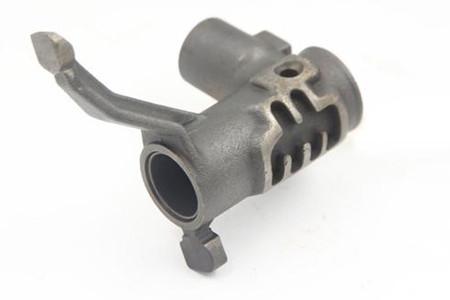Process analysis of the gearbox shift fork
Source: http://www.yonglingcn.com Time: 2022-10-08 Hits:0What is the process of the gearbox shift fork? Here's a brief introduction.
The shift fork of gearbox is sleeved on the shaft with the middle 15.8F8 hole, and is positioned with the screw hole with the screw diameter M10×1-7H. The shift fork foot is clamped in the shaft of the duplex gear, and the shift operating mechanism drives the shift fork and the shaft to slide in the gearbox through the operating slot of the shift fork head. The shift fork foot moves the duplex gear to slide on the spline shaft, so that the shift function can be realized, thus realizing the transmission speed change.
The main working surface of the shift fork is the two end faces of the shift pin of the control slot. The main mating surfaces are φ15.8F8 hole, M10×1-7H threaded hole and 51mm side of shift fork. This part belongs to a special shape part, but its complexity is general.
As the shifting fork bears certain pressure on its surface during working, it requires certain strength and toughness.
Main machined surfaces and their requirements
1. mounting hole of shift fork
The hole with the diameter of 15.8F8 is the mounting hole of the shift fork, and its shape tolerance complies with the inclusive requirements, with the surface roughness Ra of 3.2μ m and the chamfer angle of the end face of 0.4× 45.

2. End face of shift fork foot
The thickness of the shift fork end face is 5.9mm, the verticality tolerance of both ends facing the axis of the hole φ15.8F8 is 0.15mm, the distance between the inner end face and the symmetry plane of the control slot is 33.5±0.15mm, the surface roughness Ra is 6.3um, and the chamfer angle of the fork end face is 0.8× 45.
3. Inner side of shift fork foot
The width of the inner side of the shift fork is 51mm, and its symmetry plane belongs to the same plane as that of the shift fork head. The surface roughness Ra is 6.3μm, and the chamfer angle of the inner side of the shift fork is 0.8× 45.
4. Two sides of shift fork head
The thickness of the end face of the shift fork is 9.65mm, the symmetry plane is the same as the small 15.8F8 hole and the shift fork face, and the surface roughness Ra is 6.3μm m.
After reading it, do you have a general understanding of the process of shifting fork of gearbox?
- Gearbox Differential Housing
- Gearbox Shift Forks
- Gearbox Shift Fingers
- Gearbox Shift Block
- Gearbox Stainless Steel Connectors
- Gearbox balanced Connectors
- Aluminum Forks of Gearbox
- Cam Shift of Gearbox
- Shift Assembly of Gearbox
- Automotive Driving Shafts
- Automotive Brake Linking Bar
- Stainless Steel Connecting
- Elevator Brake Parts


